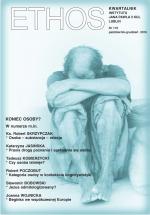O KONSEKWENCJACH DWUZNACZNOŚCI TERMINU
„TOŻSAMOŚĆ OSOBOWA”. Uwagi po lekturze książki Grażyny Osiki „Tożsamość osobowa w epoce cyfrowych technologii komunikacyjnych”
On the Consequences of the Ambiguity of the Term ‘Personal Identity’: Some Remarks on Grażyna Osika’s Book Tożsamość osobowa w epoce cyfrowych technologii komunikacyjnych
Author(s): Agnieszka Lekka-KowalikSubject(s): Christian Theology and Religion, Anthropology, Psychology
Published by: Katolicki Uniwersytet Lubelski Jana Pawła II - Instytut Jana Pawła II, Wydział Filozofii
Keywords: person; identity; personal identity; communication society; digital technologies; communication model of personal identity; classical metaphysics
Summary/Abstract: In her book Grażyna Osika discusses some contexts of developing communication society, the nature of digital technologies, conceptions of identity and the impact of digital technologies on personal identity. On this basis Osika develops a communication model of personal identity. Yet her policy of ignoring metaphysical issues and confining philosophy to the philosophy of mind becomes a source of interpretational problems. Firstly, it is sometimes diffi cult to determine of what Osika writes: the real identity of a person, the view one has of oneself, a personal experience of one’s identity, the creation of one’s personal identity, the factors that infl uence one’s identity, the term ‘personal identity’ or the concept of personal identity. The book is in fact about the impact of digital technologies on the process of creating one’s own identity in the sense of acquiring/removing certain personal traits. This is what the communication model refers to. Secondly, Osika stresses that the starting point of creating one’s own identity is the experience of one’s own existence and that the ‘I exist’ experience enables various constructions of oneself. However, Osika does not take into consideration the implications of Piotr Oleś’s distinction she herself quotes: who I am (the realm of metaphysics) and what I am (the realms of psychology, sociology, etc.). While it is true that I can construct myself and that I am infl uenced by the technologies as well as by the environment, it is so only in the aspect of my traits. As far as my essence is concerned, I am not free to construct myself. I am not a tiger, or a bird, but a person—a rational and free being with potentialities. And it is only such understanding of the human person that may provide the foundations for Osika’s communication model of personal identity. Thus, in order to ultimately justify Osika’s claims, one needs to refer to classical metaphysics.
Journal: Ethos. Kwartalnik Instytutu Jana Pawła II KUL
- Issue Year: 29/2016
- Issue No: 4
- Page Range: 306-320
- Page Count: 15
- Language: Polish
- Content File-PDF

